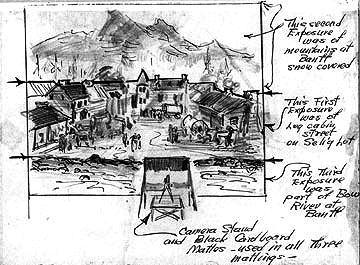WRAP SHOT

Obviously, this Wrap Shot is not a photo, but the drawing is especially appropriate for this month's American Cinematographer, which spotlights independent filmmakers. The sketch was done many years ago by Norman A. Dawn, ASC, who was the most independent moviemaker in the industry's history. The drawing displays how he achieved a three-element, in-camera matte shot for Col. William Selig's production, The Spoilers in 1914, no less! All three elements mountains in Canada, street set in California, river in Canada were live-action shots protected by black cardboard mattes.
By the time Dawn executed this triple matte shot, he was already an old pro with six years of experience. Born in Argentina in 1884, he worked in Los Angeles as a commercial artist and still photographer before he began making movies. He is the first known cinematographer to execute glass shots, which he did in 1907 to "restore" crumbling buildings on his first film, California Missions. Dawn was anxious to "dispel any notion that I invented this technique I merely built onto it and took advantage of conditions to advance an art in the making. . . One must not get the idea that other men were not doing things too. How much, will never be known." He acquired the idea, he said, from his boss at Thorpe Engraving Co. in Los Angeles, who used the method while making still photos. The boss was Max Handsheigl, who later entered the motion picture business as an inventor.
Dawn was practically a one-man movie studio. Although cinematography was his chosen profession, he also functioned as producer, director, writer, designer, visual effects cameraman, matte painter, production illustrator and film editor. He could also accomplish whatever else needed doing, including inventing equipment on the spot. For years, he traveled much of the world making travelogues with his $500 French Debrie camera, but these films were different from the usual offerings in that Dwan often utilized glass art and mattes to better their look. In South America circa 1907, he photographed Indian women bathing in a pool behind a hotel; erected on the back verandah was a plate glass window, on which Dawn painted a Mayan temple and a monument on a hill, which blended in perfectly with the live scene. In 1913 he used back projection in The Drifter.
Between expeditions in the 1920s, he directed features and also devised special photographic effects for Universal, MGM, Pathé and other companies. His pièce de résistance was the most celebrated Australian silent picture, For the Term of His Natural Life (1926), for which he built a large studio and laboratory.
Afterwards, Dawn continued to make movies on his own, including several in Alaska, such as Orphans of the North, Call of the Yukon and Tundra. He still checked into Hollywood every so often to do special effects work. After retiring, he continued his photographic experiments until his death in 1975 at the age of 88.